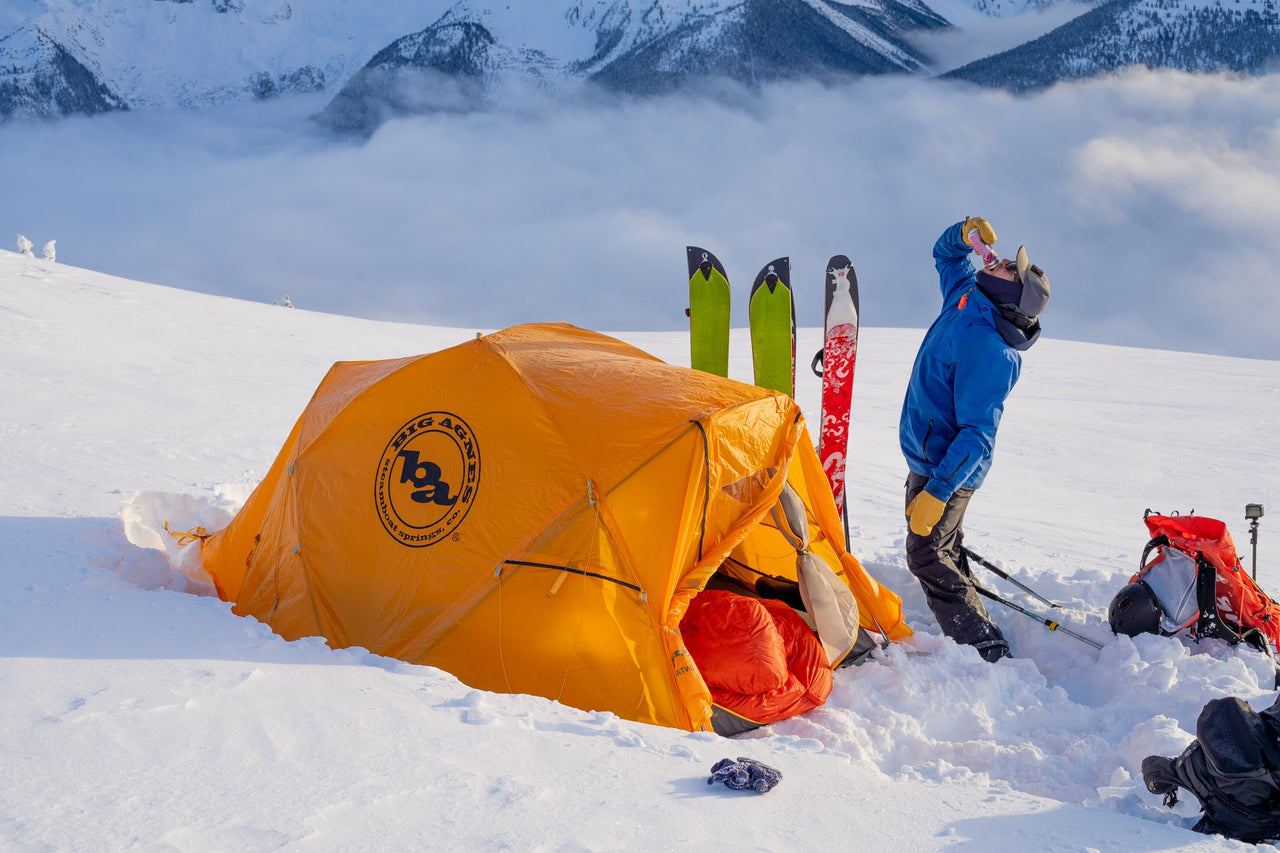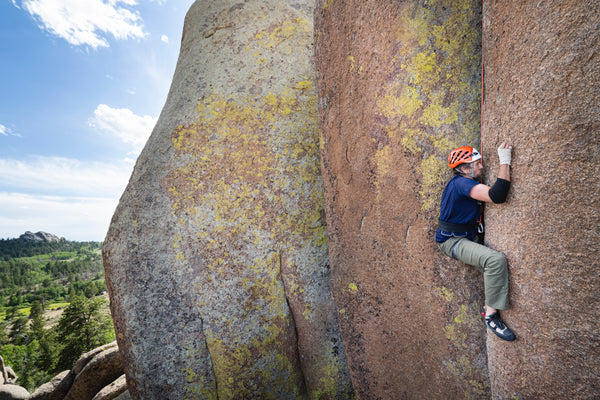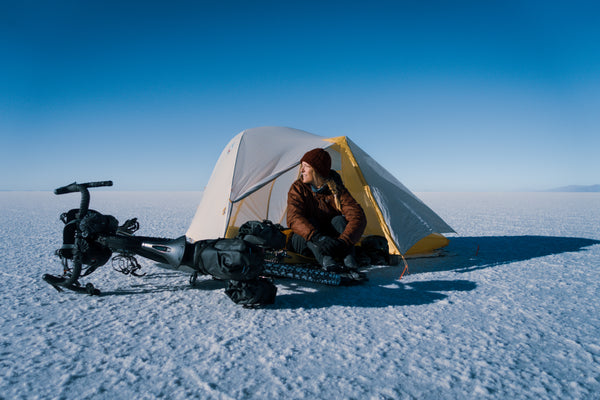So, you want to try winter camping. Having tried and failed to enjoy this pretty niche activity a few times, I’m here with some advice for you. Hopefully these tips help you avoid the mistakes I made, and get you stuck into the best parts of winter camping. There are quite a few benefits to winter camping versus summer camping. There are no bugs (major win), not much prowling wildlife, and you can be sure you’re first in line to ski the big line you’ve been eyeing up all season.
Your winter camping experience will only be as good as your equipment, big and small. No matter how stunning your location might be, or how much pow you shredded that day, there’s nothing that can put a damper on your experience like a long, cold night spent shivering in your tent. If you’re anything like me, when you’re cold, you’re pretty damn miserable. So let’s break down how to have the warmest (and funnest) winter camping experience.
Use a tent that’s made for winter camping
This is probably the main pillar of a successful night in the snow. I have tried winter camping in a flimsy 3-season tent and a -12 degree sleeping bag and I didn’t sleep a wink. It also took me 2 hours in the bathtub the next day to warm up properly! Fumbling with zips, packing down your tent with numb fingers and putting on frozen ski boots when your core is already feeling chilled has to be up there with one of the worst experiences, EVER.
The Big Agnes Battle Mountain is the one tent to rule them all. It is windproof, weatherproof, warm and spacious – everything you want in a winter camping tent. It’s also easy to split the tent components amongst partners and share the weight (yes I do make my boyfriend carry the heavier half). Plus, this tent is yellow which, let’s face it, is awesome for photos.
Next up, don’t skimp on the sleeping bag
I’m not going to lie, once I tried the Cinnabar sleeping bag, I was ruined forever. In a word, it is PLUSH. With temp rating options at –20 and –40, no other bag will ever compare for being comfortable in the cold. It is like lying in a fluffy cloud of dreams that I’m pretty sure I could sleep on in the snow itself and be cozy warm, truly the perfect winter camping sleeping bag. It’s hard to explain, but when you get inside this bag, you instantly feel warm.
As a perpetually cold person, I found that upgrading my sleeping bag has made an enormous difference to my comfort levels and quality of my night’s sleep. My favorite part of this bag is the arm pockets, which make it easy to maneuver and do all your camping admin inside your tent, without getting out of your sleeping bag! I’m a side sleeper and find it super roomy so I can fidget to my heart’s delight without feeling claustrophobic.
Set yourself up for success
Location is everything. When pitching your tent, pick a spot that’s sheltered from the wind and away from any avalanche danger. It’s also worth noting if you’re east-facing; a spot that will be hit early by the sun when it rises will help you warm up faster. Prep your tent site by packing down the snow with an avalanche shovel. You want a nice flat surface, and if it’s super windy, consider building a wind wall.

What I find most helpful when winter camping is digging a pit outside the entrance of your tent. I tend to dig a pit about 3 feet down and 4 feet wide, providing a platform where you can sit down in the tent door to take off or put on your ski boots and rummage through your pack. If you have a vestibule or tarp, this also increases your tent storage hugely, as you won’t have to keep everything inside! Just make sure to keep everything covered as blizzards can hit unexpectedly.
Eat, drink and be merry.
It can be hard to be motivated to drink cold water when you’re already feeling the cold. It’s important to bring as much water with you as you can reasonably carry, as melting snow is tedious and takes a long time! At camp, a great way to warm up and rehydrate is by making hot drinks, like herbal tea or hot chocolate, and obviously coffee for the morning. If space allows, I also like to carry a thermos of hot tea with me on my daytime adventures.
Winter camping burns a lot of calories, you’re using a lot of energy to just keep warm. If you plan on ski touring, or other winter activities that burn even more calories, you’ll want to be prepared with high-calorie foods to replenish your energy stores. A hot, calorific meal while winter camping is especially gratifying.
I find it best to keep my meals simple so I’m not stuck cleaning lots of dishes in the cold (frozen, sticky oatmeal in my fancy MSR pan? No thanks). . I accompany every meal (even breakfast!) with a miso soup to hit my sodium cravings, and tend to go for rehydrated meals that I can eat right out of the bag. Top tip, invest in a long spoon so that you’re not getting your fingers mucky when you eat bagged meals! That way, my stove pan is always clean to melt snow and boil water.
If I were to go sled-access or car-access camping (i.e., weight wasn’t an issue), I would go for something hearty and filling like gnocchi that cooks in just a couple of minutes. Delicious, but pretty heavy to carry. The experts will probably tell you not to drink, but hey, I’ve always got a flask of whisky with me to take the edge off the colder temps before I snuggle into bed.

A Few Extra Pro Tips For Winter Camping
Change your clothes at night.
When camping, I always have two sets of clothes: one set for daytime and one set for nighttime. Switch into your nighttime clothes as soon as you get to camp, so that the sweat of the day doesn’t catch a chill once you’ve stopped moving. You’ll get cold fast, so switch layers and then pop your puffy on.
Go pee when you need to.
There’s nothing worse than laying on your back all night, willing the need to pee to naturally go away by itself. That nagging sensation isn’t going to disappear, and fatigue will only make you feel colder. Get it done and then get to sleep!
Spoon your water bottle.
Fill up your Nalgene with hot water and bring it inside your sleeping bag for a hot water bottle to snuggle at night! For winter camping, I find it best to use wide mouth bottles that you can pour boiling water into each morning. The narrow mouth bottles can be a little harder to aim at, and the last thing you want is to spill water on yourself that will freeze. Been there, done that.
Use your body as a dryer.
If your daytime clothes, gloves, or socks get wet, put them inside your sleeping bag (I put them atop my bare skin). Your body heat will dry them, so you aren’t putting cold, wet clothes on the next day. You’d think it would feel crowded in there, but the Cinnabar is so roomy that you can’t even notice!

Sleep nakey.
It might sound crazy but sleeping in your undies or full nudey is the way to go. This is especially true if all your layers are a little damp. I wear Merino wool whenever I’m touring, it’s fantastic for sweat wicking and temperature control when you’re active, but at night I prefer to let my body heat come into close contact with my Cinnabar for the best insulating experience.
Keep electronics warm.
Cold temps can drain battery power insanely fast. When not in use, stow things like your headlamp, cell phone, satellite phone and extra batteries in your sleeping bag or jacket pocket close to your body.
Warm feet = Happiness.
Bring your ski or snow boots inside your tent at night to make it a lot more pleasant to put them on in the morning. If your boots have removable liners, keep them warm at night by putting them in your sleeping bag or even sleep with them on.
Don’t forget your hut booties! Having a dry, comfy pair of tent slippers to change into for around camp is essential. Most hut booties these days are also designed for walking on snow, so you don’t need multiple pairs of shoes for your time at camp.
Be ready for anything.
Things go south quickly when the weather turns. Technical difficulties happen and there can be unexpected delays where you are exposed to storm weather, even if it isn’t forecasted. A satellite communication device, such as an InReach, will ensure you can reach help if anything goes amuck. Use Leave No Trace ethics and be sure to have a robust understanding of the avalanche danger in your region and know how to use your avalanche safety gear.
About the Author: Christie is an adventure and film photographer based in Whistler. She spends her summers hiking, biking, and road tripping throughout British Columbia, and her winters skiing in the Coast Mountains. Her favorite things to write about are misadventures (of which she has had plenty), backcountry gear, and film cameras. Usually found in the pub on a Sunday after a day trying to enjoy ski touring.


 English (EUR) | EN
English (EUR) | EN 


